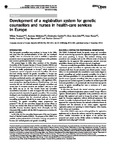Development of a registration system for genetic counsellors and nurses in health-care services in Europe
| dc.contributor.author | Paneque, M | |
| dc.contributor.author | Moldovan, R | |
| dc.contributor.author | Cordier, C | |
| dc.contributor.author | Serra-Juhé, C | |
| dc.contributor.author | Feroce, I | |
| dc.contributor.author | Lambert, D | |
| dc.contributor.author | Bjørnevoll, I | |
| dc.contributor.author | Skirton, H | |
| dc.date.accessioned | 2016-09-29T11:19:24Z | |
| dc.date.available | 2016-09-29T11:19:24Z | |
| dc.date.issued | 2016-03 | |
| dc.identifier.issn | 1018-4813 | |
| dc.identifier.issn | 1476-5438 | |
| dc.identifier.uri | http://hdl.handle.net/10026.1/5504 | |
| dc.description.abstract |
INTRODUCTION. The first genetic counsellors were employed in Europe in the 1980s, and since then the professionalisation of the role has developed rapidly. Here we summarise the work to establish a registration process to ensure an appropriate level of competence in the profession and common professional standards in Europe. The process began in 2006, when members of the Education Committee of the European Society of Human Genetics (ESHG) and the EuroGentest project prepared a document ‘Core competences in genetics for health professionals in Europe’, which included the competences required of genetic nurses and counsellors. The education and training required for genetic counsellors in Europe was heterogeneous and most countries had not developed standards for education, professional practice, and registration. Some countries had specific programmes in genetic counselling – with significant differences among them regarding duration or clinical training – but most countries had not. An informal network of genetic counsellors and nurses from 23 European countries was initiated. Later on, in 2009 the ESHG set up an Ad Hoc Genetic Nurse and Counsellor Accreditation Committee in order to support the work of ensuring adequate standards of practice for genetic counsellors. This committee developed a set of professional standards for education and a code of practice. It proposed that the educational pathway for genetic counselling professionals should be at master level, and a European curriculum for genetic counselling master programmes was prepared. The Ad Hoc committee assessed the courses offered in Europe and decided that those at Cardiff (UK), Manchester (UK), Marseille (France), Barcelona (Spain), Porto (Portugal), and Cluj (Romania) fully complied with the 2006 European core curriculum for genetic counsellors. In 2012 the Ad Hoc committee became part of the new European Board of Medical Genetics (EBMG). The purpose of the EBMG is to establish professional standards of education, training, and practice in human, and medical genetics and genetic counselling. | |
| dc.format.extent | 312-314 | |
| dc.format.medium | Print-Electronic | |
| dc.language | en | |
| dc.language.iso | eng | |
| dc.publisher | Springer Science and Business Media LLC | |
| dc.subject | Accreditation | |
| dc.subject | Europe | |
| dc.subject | Genetic Counseling | |
| dc.subject | Health Services | |
| dc.subject | Humans | |
| dc.subject | Nurses | |
| dc.subject | Professional Competence | |
| dc.title | Development of a registration system for genetic counsellors and nurses in health-care services in Europe | |
| dc.type | journal-article | |
| dc.type | Article | |
| plymouth.author-url | https://www.ncbi.nlm.nih.gov/pubmed/26531169 | |
| plymouth.issue | 3 | |
| plymouth.volume | 24 | |
| plymouth.publication-status | Published | |
| plymouth.journal | European Journal of Human Genetics | |
| dc.identifier.doi | 10.1038/ejhg.2015.234 | |
| plymouth.organisational-group | /Plymouth | |
| plymouth.organisational-group | /Plymouth/Faculty of Health | |
| dc.publisher.place | England | |
| dcterms.dateAccepted | 2015-01-01 | |
| dc.rights.embargodate | 2023-9-29 | |
| dc.identifier.eissn | 1476-5438 | |
| dc.rights.embargoperiod | Not known | |
| rioxxterms.versionofrecord | 10.1038/ejhg.2015.234 | |
| rioxxterms.licenseref.uri | http://www.rioxx.net/licenses/all-rights-reserved | |
| rioxxterms.licenseref.startdate | 2016-03 | |
| rioxxterms.type | Journal Article/Review |


